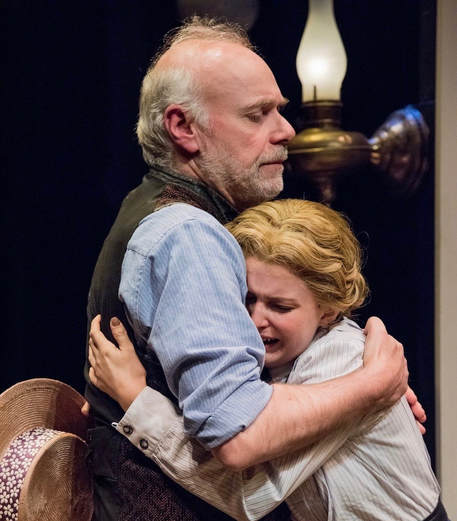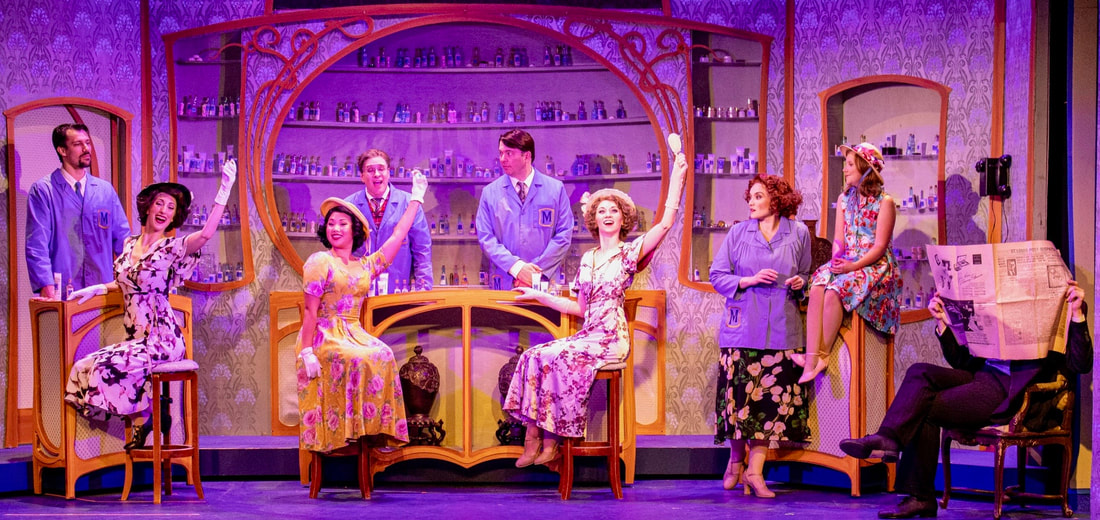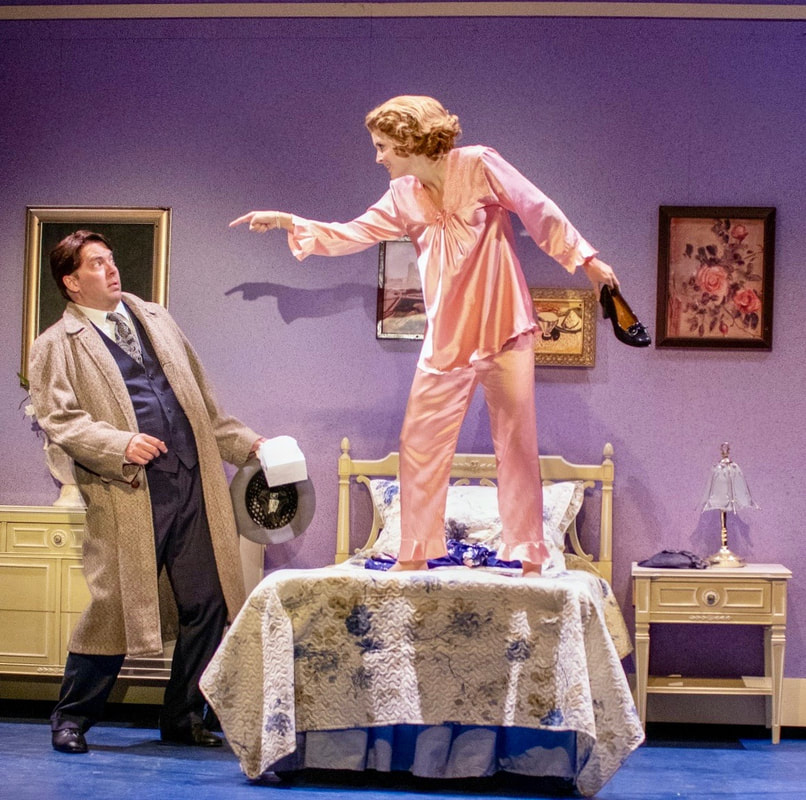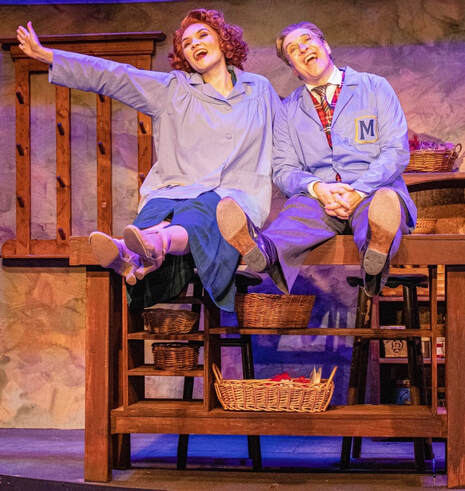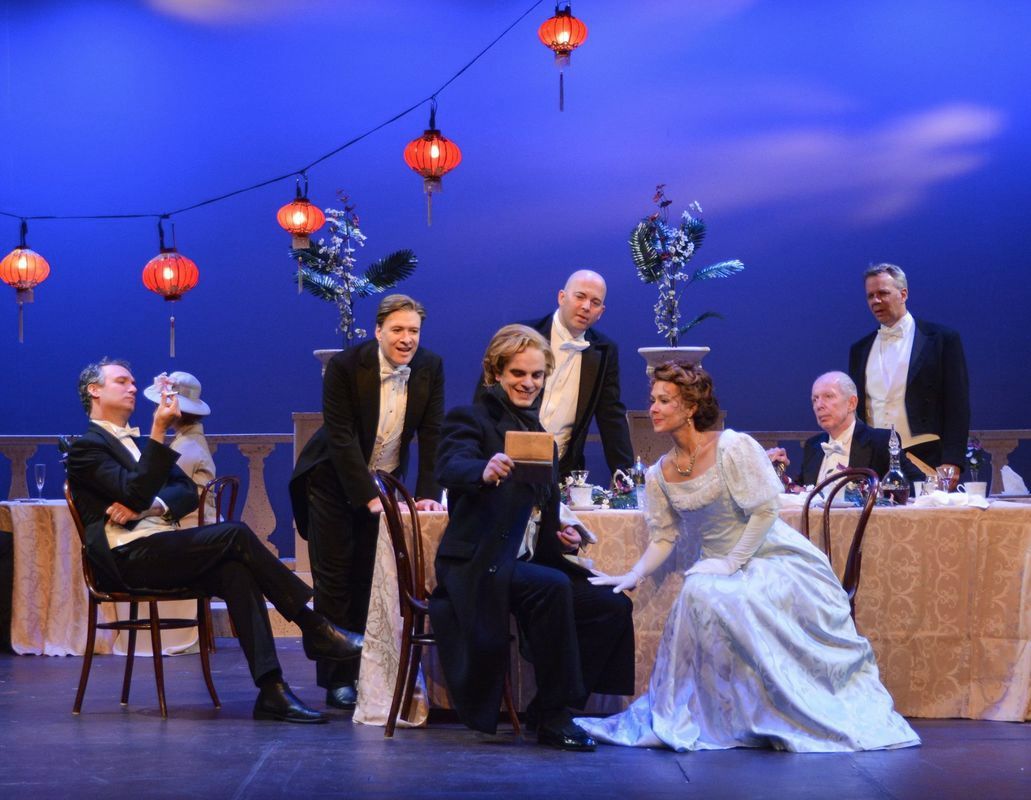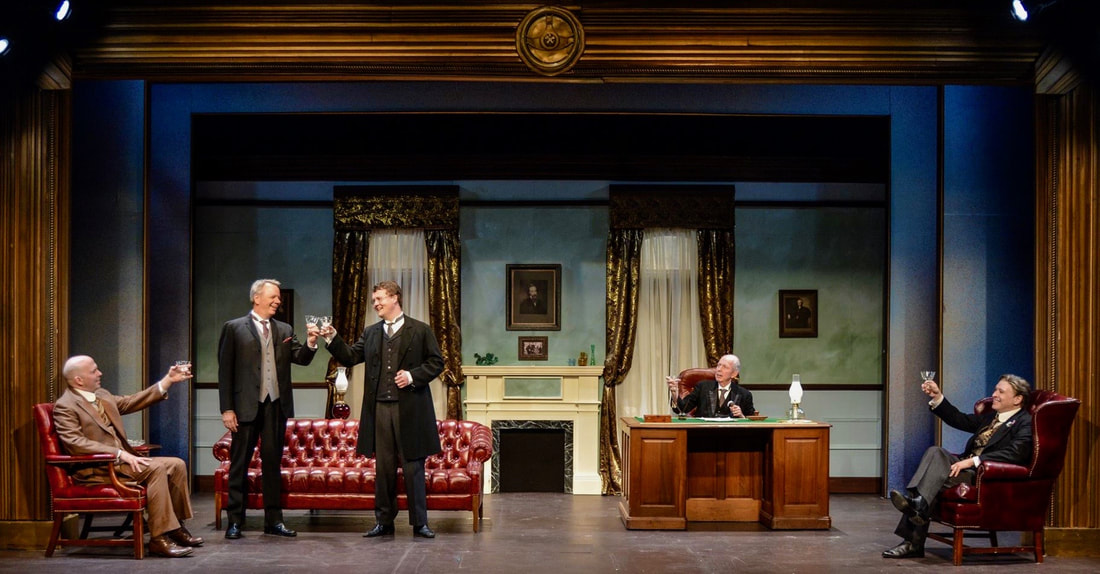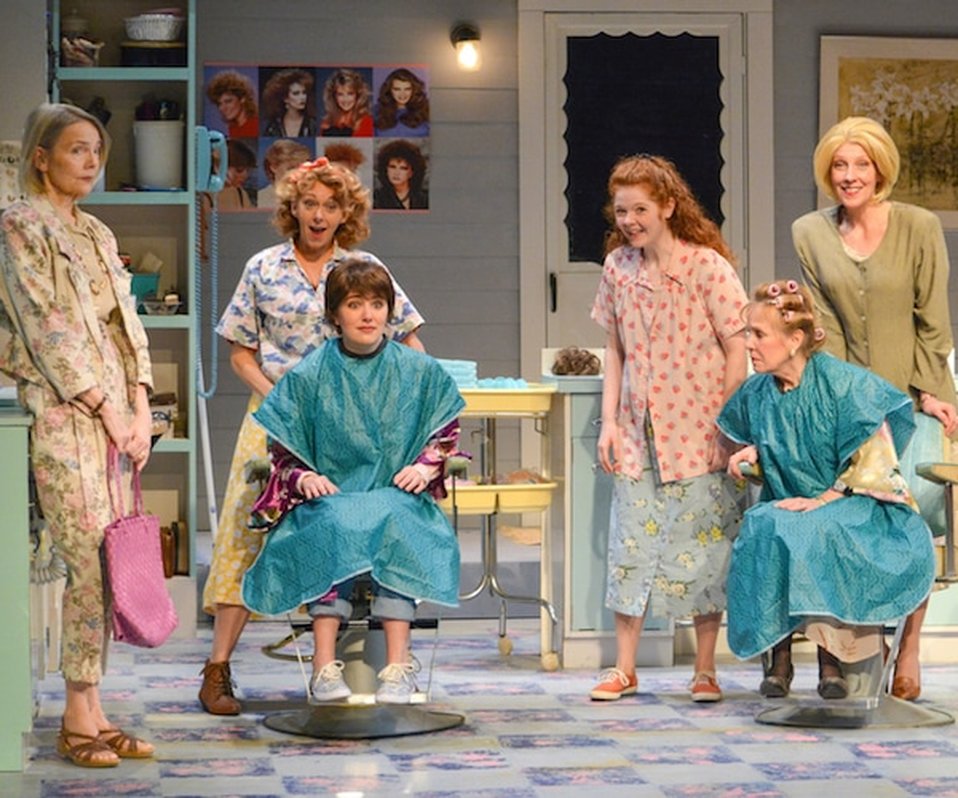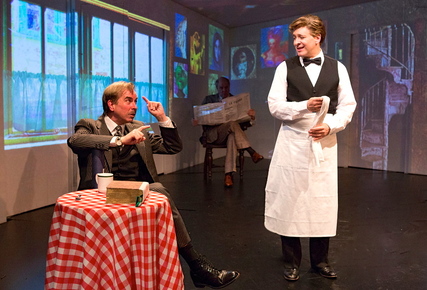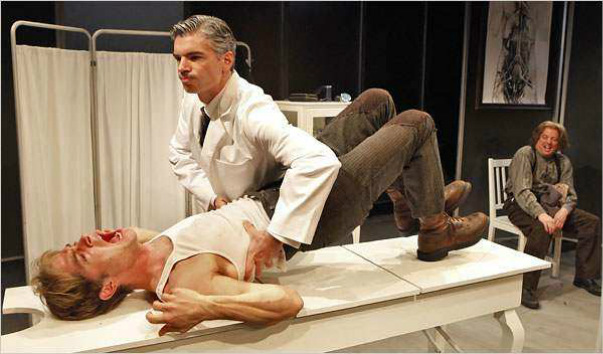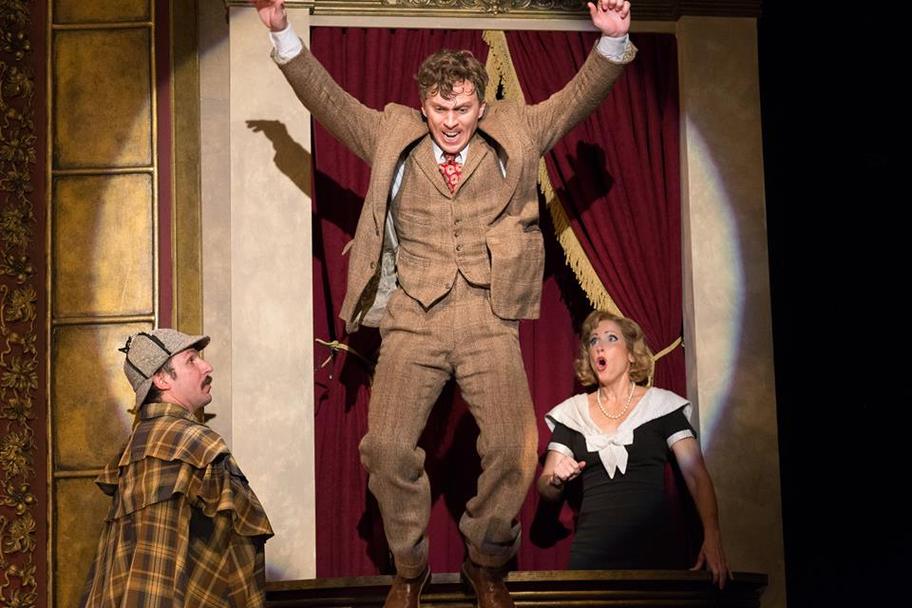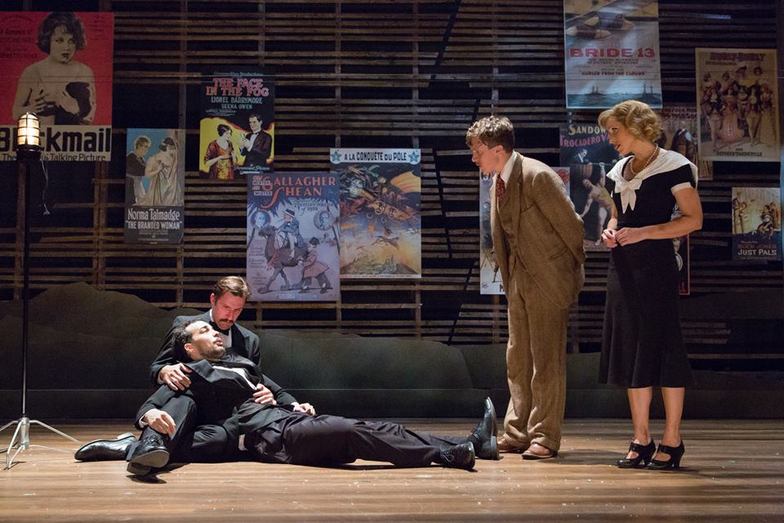HINDLE WAKES by Stanley Houghton.
A Mint Theater production at the Clurman Theater, NYC, Dec-Feb 2017-2018. Drama Desk Award nomination for Outstanding Revival of a Play 2018.
Off Broadway Alliance nomination for Best Revival of a Play 2018.
Newsweek: 10 Best of New York Theater in 2018.
Under Gus Kaikkonen's meticulous, understated direction, a way of life and its assumptions and ideals are overturned by a capitalism-inspired vision of individual satisfaction. The production is filled with telling details. Fanny ingratiatingly pushing a box of candy toward her mother, who coolly pushes it back; Alan entering the house inebriated and knocking over a set of fireplace tools before slumping in a chair; Nathaniel displacing his anxiety about a forthcoming confrontation by snapping at the maid. The standouts in the cast include Jonathan Hogan as Nathaniel, whose quiet manner masks a deep pleasure in the exercise of power; Sandra Shipley as Mrs. Hawthorn, who sourly denounces Fanny while greedily imagining the prospect of a wealthy son-in-law, and Jeremy Beck, whose Alan is an entitled man-boy, convinced that nothing is ever his fault. There are especially striking contributions from Emma Geer as Beatrice, who with shining eyes, informs Alan that he has an opportunity to make "a really splendid sacrifice" by wedding Fanny, and Rebecca Noelle Brinkley, whose cold-eyed skepticism scandalizes the elders. ("I'll trouble you to talk to me without swearing at me," she tells Nathaniel. "I'm not a member of the family yet.")
The play's theme is neatly embodied in Charles Morgan's set design, which locates both the Hawthorns' kitchen and the Jeffcotes' breakfast room within a kind of skeletal iron gazebo structure, each of its ribs adorned with industrial gears, each scene given a mellow gaslight glow by Christian DeAngelis' lighting. It's as if the Industrial Revolution has reached out, holding all the characters in its chilly embrace. Sam Fleming's costumes draw strict lines between the classes. Jane Shaw has provided rippling harp themes that underline the action with a touch of sadness, along with some startling thunder effects.
This revival of Hindle Wakes--a play not seen in New York since 1922--effectively immerses us in a world where the mere hint of impurity is enough to destroy a young woman's reputation, causing her parents to frantically book a church. (Fanny isn't even pregnant; she and Alan merely slipped away for a couple of days.) But the clock is ticking: A new morality is being born. Will it bring about something better than the chilly maneuverings of the Hawthorns and the Jeffcotes? We all know the answer to that question. -- David Barbour, LIGHTING AND SOUND AMERICA, 19 January 2018
The play's theme is neatly embodied in Charles Morgan's set design, which locates both the Hawthorns' kitchen and the Jeffcotes' breakfast room within a kind of skeletal iron gazebo structure, each of its ribs adorned with industrial gears, each scene given a mellow gaslight glow by Christian DeAngelis' lighting. It's as if the Industrial Revolution has reached out, holding all the characters in its chilly embrace. Sam Fleming's costumes draw strict lines between the classes. Jane Shaw has provided rippling harp themes that underline the action with a touch of sadness, along with some startling thunder effects.
This revival of Hindle Wakes--a play not seen in New York since 1922--effectively immerses us in a world where the mere hint of impurity is enough to destroy a young woman's reputation, causing her parents to frantically book a church. (Fanny isn't even pregnant; she and Alan merely slipped away for a couple of days.) But the clock is ticking: A new morality is being born. Will it bring about something better than the chilly maneuverings of the Hawthorns and the Jeffcotes? We all know the answer to that question. -- David Barbour, LIGHTING AND SOUND AMERICA, 19 January 2018
WALL STREET JOURNAL
A Forgotten Playwright, Freshly Minted
By TERRY TEACHOUT
Of all the countless off-Broadway troupes with which the side streets of Manhattan are dotted, none has a more distinctive mission—or a higher artistic batting average—than the Mint Theater Company, which “finds and produces worthwhile plays from the past that have been lost or forgotten.” If that sounds dull to you, don’t be fooled: I’ve never seen a production there that was a sliver less than superb. Rachel Crothers’s “Susan and God,” John Galsworthy’s “The Skin Game,” Harley Granville-Barker’s “The Madras House,” N.C. Hunter’s “A Day by the Sea,” Dawn Powell’s “Walking Down Broadway,” Jules Romains’s “Doctor Knock,” John Van Druten’s “London Wall”: All these fine plays and others just as good have been exhumed by the Mint to memorable effect in the 13 years that I’ve been reviewing the company, a tribute to the uncanny taste and unfailing resourcefulness of Jonathan Bank, the artistic director.
This time around, though, Mr. Bank has really pulled one out of his seemingly bottomless hat. I’d never even heard the name of Stanley Houghton, an English playwright who died in 1913 at the age of 32, before the Mint announced its latest revival, a Houghton play called “Hindle Wakes” that hasn’t been staged in the U.S. since 1922. Were it being produced by any other company in New York, I’d probably have passed on so obscure an offering, but the Mint’s infallible record of success led me to roll the dice. It was the right call, too: Not only was Houghton an artist of exceptional skill, but “Hindle Wakes,” his last play, is a study of provincial hypocrisy in Vicwardian England that crackles with a biting candor fully worthy of George Bernard Shaw, on whose far better-known plays it was plainly modeled.
Fanny Hawthorn ( Rebecca Noelle Brinkley ), the sparky Lancashire lass at the center of “Hindle Wakes,” lives with her working-class parents ( Ken Marks and Sandra Shipley ) and toils alongside Christopher, her father, in Hindle’s cotton mill. She’s returned home much later than expected from what the Brits used to call a “dirty weekend” with Alan Jeffcote ( Jeremy Beck ), a hard-drinking young man about town. No sooner do the Hawthorns confront Fanny, demanding that she tell them where she went and what she did there, than Christopher pays an unscheduled call on Alan’s father, Nathaniel ( Jonathan Hogan ), the owner of the mill and the richest man in town. The objective, naturally, is to force Alan to make an honest woman out of Fanny, but that’s where the plot starts to thicken. Nathaniel, it seems, is a childhood friend of Christopher who clawed his way up the greasy pole of success. What’s more, he’s about to marry off his ne’er-do-well son to Beatrice ( Emma Geer ), the mayor’s daughter, thereby securing for himself and his wife ( Jill Tanner ) a place in society that the money of a self-made businessman who “started life in a weaving shed” can’t buy.
What we have here, in short, is a standard-issue clockwork melodrama—except that “Hindle Wakes” proves to be nothing of the kind. The difference is that save for Fanny’s earnest, hapless father, all of the characters respond to her dilemma in unexpected ways, none more so than Nathaniel, a coolly sardonic businessman in the Trollopian mold: “Money’s power. That’s why I like money. Not for what it can buy....Why did I buy a motor-car? Not because I wanted to go motoring. I hate it. I bought it so that people could see Alan driving about in it, and say, ‘There’s Jeffcote’s lad in his new car. It cost five hundred quid.’” Yet for all his chilly realism, Nathaniel has a second surprise up his sleeve. He, too, means to make his son do the right thing—whatever the cost.
Gus Kaikkonen, whose work with the Mint and his own Peterborough Players in New Hampshire long ago established him as one of the deftest directors on the East Coast, has staged “Hindle Wakes” with the same crisp understatement that he brought to his 2017 Peterborough Players revival of Shaw’s “The Doctor’s Dilemma,” letting Houghton make his own stiletto-sharp points instead of ramming them home. His ensemble cast, led by the superlative Mr. Hogan, acts in the same unexaggerated spirit, aided by the dialect coaching of Amy Stoller, who has gone to enormous trouble to ensure that everyone in the company nails the savory “Lankysheer” accent specified in the script. I’m thrilled to discover at long last so unjustly forgotten a playwright, and eager to see more of his work.
A Forgotten Playwright, Freshly Minted
By TERRY TEACHOUT
Of all the countless off-Broadway troupes with which the side streets of Manhattan are dotted, none has a more distinctive mission—or a higher artistic batting average—than the Mint Theater Company, which “finds and produces worthwhile plays from the past that have been lost or forgotten.” If that sounds dull to you, don’t be fooled: I’ve never seen a production there that was a sliver less than superb. Rachel Crothers’s “Susan and God,” John Galsworthy’s “The Skin Game,” Harley Granville-Barker’s “The Madras House,” N.C. Hunter’s “A Day by the Sea,” Dawn Powell’s “Walking Down Broadway,” Jules Romains’s “Doctor Knock,” John Van Druten’s “London Wall”: All these fine plays and others just as good have been exhumed by the Mint to memorable effect in the 13 years that I’ve been reviewing the company, a tribute to the uncanny taste and unfailing resourcefulness of Jonathan Bank, the artistic director.
This time around, though, Mr. Bank has really pulled one out of his seemingly bottomless hat. I’d never even heard the name of Stanley Houghton, an English playwright who died in 1913 at the age of 32, before the Mint announced its latest revival, a Houghton play called “Hindle Wakes” that hasn’t been staged in the U.S. since 1922. Were it being produced by any other company in New York, I’d probably have passed on so obscure an offering, but the Mint’s infallible record of success led me to roll the dice. It was the right call, too: Not only was Houghton an artist of exceptional skill, but “Hindle Wakes,” his last play, is a study of provincial hypocrisy in Vicwardian England that crackles with a biting candor fully worthy of George Bernard Shaw, on whose far better-known plays it was plainly modeled.
Fanny Hawthorn ( Rebecca Noelle Brinkley ), the sparky Lancashire lass at the center of “Hindle Wakes,” lives with her working-class parents ( Ken Marks and Sandra Shipley ) and toils alongside Christopher, her father, in Hindle’s cotton mill. She’s returned home much later than expected from what the Brits used to call a “dirty weekend” with Alan Jeffcote ( Jeremy Beck ), a hard-drinking young man about town. No sooner do the Hawthorns confront Fanny, demanding that she tell them where she went and what she did there, than Christopher pays an unscheduled call on Alan’s father, Nathaniel ( Jonathan Hogan ), the owner of the mill and the richest man in town. The objective, naturally, is to force Alan to make an honest woman out of Fanny, but that’s where the plot starts to thicken. Nathaniel, it seems, is a childhood friend of Christopher who clawed his way up the greasy pole of success. What’s more, he’s about to marry off his ne’er-do-well son to Beatrice ( Emma Geer ), the mayor’s daughter, thereby securing for himself and his wife ( Jill Tanner ) a place in society that the money of a self-made businessman who “started life in a weaving shed” can’t buy.
What we have here, in short, is a standard-issue clockwork melodrama—except that “Hindle Wakes” proves to be nothing of the kind. The difference is that save for Fanny’s earnest, hapless father, all of the characters respond to her dilemma in unexpected ways, none more so than Nathaniel, a coolly sardonic businessman in the Trollopian mold: “Money’s power. That’s why I like money. Not for what it can buy....Why did I buy a motor-car? Not because I wanted to go motoring. I hate it. I bought it so that people could see Alan driving about in it, and say, ‘There’s Jeffcote’s lad in his new car. It cost five hundred quid.’” Yet for all his chilly realism, Nathaniel has a second surprise up his sleeve. He, too, means to make his son do the right thing—whatever the cost.
Gus Kaikkonen, whose work with the Mint and his own Peterborough Players in New Hampshire long ago established him as one of the deftest directors on the East Coast, has staged “Hindle Wakes” with the same crisp understatement that he brought to his 2017 Peterborough Players revival of Shaw’s “The Doctor’s Dilemma,” letting Houghton make his own stiletto-sharp points instead of ramming them home. His ensemble cast, led by the superlative Mr. Hogan, acts in the same unexaggerated spirit, aided by the dialect coaching of Amy Stoller, who has gone to enormous trouble to ensure that everyone in the company nails the savory “Lankysheer” accent specified in the script. I’m thrilled to discover at long last so unjustly forgotten a playwright, and eager to see more of his work.
The Immigrant, by Mark Harelik Sarasota Jewish Theatre, May 2024
TEN MINUTES, PLEASE written and directed by Gus Kaikkonen. Chain Theatre 2024 Winter One Act Festival, NYC
GERTRUDE STEIN AND A COMPANION at Peterborough, July 2019
SHE LOVES ME at Peterborough Players, July-August 2019
THE SKIN OF OUR TEETH by Thorton Wilder at Peterborough Players July 2018
|
THE MAN OF DESTINY by George Bernard Shaw at Peterborough, August 2018
The Doctor's Dilemma by George Bernard Shaw
Winner: Best Director of a Play at the 2017 New Hampshire Theater Awards.
THE WALL STREET JOURNAL
THE DOCTOR'S DILEMMA: HITTING THE ROAD IN SEARCH OF A MASTER
Terry Teachout
Aug. 17, 2017
Peterborough, N.H.
In America, the plays of George Bernard Shaw have been increasingly relegated to summer festivals in recent years. Only six have been revived on Broadway in the past quarter-century—a pitifully small showing for a playwright whose work was once a staple of the commercial theater—and many regional companies also steer clear of their big casts and bristling intellectual challenges. That’s one reason why I hit the road: Shaw was a supremely great theatrical artist whose plays are both thought-provoking and wonderfully funny, and I’m willing to go far out of my way to see his work done well. Up in New Hampshire, Gus Kaikkonen’s Peterborough Players have a long record of doing very well by Shaw, and their latest production, a rare staging of “The Doctor’s Dilemma,” is distinguished even by their own high standards.
First performed in 1906, “The Doctor’s Dilemma” is an uproariously funny comedy about a deadly serious subject. Sir Colenso Ridgeon ( David Haugen ), the title character, is a newly knighted London physician who finds himself faced with a horrific either-or choice: Should he save the life of a potentially great painter (William Champion) who’s also a sociopathic rogue, or a good-hearted, ne’er-do-well fellow doctor ( Cory Buffaloe ) who looks after the poor? If that’s not enough of a conundrum, Shaw gives the screw yet another twist by making Sir Colenso fall in love with the artist’s wife ( Karron Graves ). Stir in a sardonic elder statesman of medicine ( Jonathan Hogan ) and two boobishly maladroit high-society doctors ( Tom Frey and Kraig Swartz ) and you’ve got a can’t-miss recipe for moral complexity, one that lands with particular force at a moment when America is debating the vexing problem of who gets what in health care. That Shaw should have chosen to frame the problem in comic terms is characteristic, as is the pithy explanation of why he has done so that he puts into Sir Colenso’s mouth: “Life does not cease to be funny when people die any more than it ceases to be serious when people laugh.”
In addition to staging “The Doctor’s Dilemma” with cracker-crisp precision, Mr. Kaikkonen has put together an ensemble cast as talented as any you’d expect to see on a New York stage. He’s also enlisted the invaluable services of Charles Morgan, who designed the sets for the Mint Theatre’s off-Broadway revivals of “A Day by the Sea” and “A Picture of Autumn” and who here works the miracle of cramming four elaborate Vicwardian interiors onto the slightly-larger-than-tiny stage of the 250-seat converted 18th-century barn in which the Peterborough Players have been performing since 1933. It all adds up to a revival brought off with such exhilarating comic flair that you might almost be watching a farce by Alan Ayckbourn or Neil Simon instead of a Shavian play-of-ideas.
THE PRODUCERS at Peterborough Players August 2017
Winner: Best Director of a Musical at 2017 New Hampshire Theater Awards.
JAMES AND THE GIANT PEACH at PETERBOROUGH
STELLA AND LOU by Bruce Graham at Peterborough Players
STEEL MAGNOLIAS at the Peterborough Players February 2017
STEEL MAGNOLIAS trades in sincerity, and it pays dividends
Friday, February 17, 2017 Jason Frank for the Monadnock Ledger Transcript
In an age where cynicism is all the rage, perhaps something earnest is necessary to put things in perspective. Luckily for the residents of Peterborough, impassioned sincerity is being produced in bucketfuls over at the Peterborough Players in their production of Steel Magnolias. Yes, over in Truvy's Salon, emotion isn't frowned upon, and an outburst can be truly appreciated if appropriate. In that monochromatically turquoise establishment, six women talk with love and goodwill as if there was no other way.
Backing up, Steel Magnolias, is the story of six women of varying ages in a small Louisiana town. One of them, Truvy (Brenny Rabine) owns a salon that has become the women's gathering place. Members include a mother-daughter pairing, a new employee and two rich older women. The title refers to the women, who are as strong as steel but as fragile as a magnolia flower.
The aforementioned earnestness isn't to say the play is bereft of humor. Nothing could be further than the truth. The six women that Steel Magnolias chooses to focus in on all have their moments of sly wit, biting criticism, and laugh out loud moments. Yet, underneath that is a permanent sense of love for one another that emanates with no sign of stopping.
Each member of the cast imbues her designated character with such a sense of life and specificity that mere minutes into the play it is hard to imagine that these women haven't been friends for years. Throughout most of the production, a sense of pleasant lightheartedness fills the theater which would absolutely be impossible without the expert portrayals that each actress provides. Then, when the play takes a turn towards the profound near its end, they all prove that dramatic chops are no issue either. The standout is Lisa Bostnar as M'Lynn, who is all but defined by her family, most significantly her daughter. If you're one of the few that doesn't know the story, I won't spoil it, but know that Bostnar gives a monologue that would be worth the price of admission all on its own.
Truly, in a time of frigidity both literal and figurative, take some time out and go visit a salon. The women there are tough, loving, and perhaps warm enough to melt even the coldest of hearts.
Friday, February 17, 2017 Jason Frank for the Monadnock Ledger Transcript
In an age where cynicism is all the rage, perhaps something earnest is necessary to put things in perspective. Luckily for the residents of Peterborough, impassioned sincerity is being produced in bucketfuls over at the Peterborough Players in their production of Steel Magnolias. Yes, over in Truvy's Salon, emotion isn't frowned upon, and an outburst can be truly appreciated if appropriate. In that monochromatically turquoise establishment, six women talk with love and goodwill as if there was no other way.
Backing up, Steel Magnolias, is the story of six women of varying ages in a small Louisiana town. One of them, Truvy (Brenny Rabine) owns a salon that has become the women's gathering place. Members include a mother-daughter pairing, a new employee and two rich older women. The title refers to the women, who are as strong as steel but as fragile as a magnolia flower.
The aforementioned earnestness isn't to say the play is bereft of humor. Nothing could be further than the truth. The six women that Steel Magnolias chooses to focus in on all have their moments of sly wit, biting criticism, and laugh out loud moments. Yet, underneath that is a permanent sense of love for one another that emanates with no sign of stopping.
Each member of the cast imbues her designated character with such a sense of life and specificity that mere minutes into the play it is hard to imagine that these women haven't been friends for years. Throughout most of the production, a sense of pleasant lightheartedness fills the theater which would absolutely be impossible without the expert portrayals that each actress provides. Then, when the play takes a turn towards the profound near its end, they all prove that dramatic chops are no issue either. The standout is Lisa Bostnar as M'Lynn, who is all but defined by her family, most significantly her daughter. If you're one of the few that doesn't know the story, I won't spoil it, but know that Bostnar gives a monologue that would be worth the price of admission all on its own.
Truly, in a time of frigidity both literal and figurative, take some time out and go visit a salon. The women there are tough, loving, and perhaps warm enough to melt even the coldest of hearts.
VANYA, SONIA, MASHA AND SPIKE at Peterborough Players, July 2016
PYGMALION at Peterborough Players, August 2016
New Jersey Symphony Orchestra at the NJ Performing Arts Center, conducted by Jacques Lacombe.
January 22, 2016
Stage direction and new translation of Berlioz's LELIO by
Gus Kaikkonen.
|
INTIMATE EXCHANGES
Wall Street Journal, Terry Teachout July 2, 2015 "Nobody stages Mr. Aykbourn's work better than the playwright himself, but Gus Kaikkonen, Peterborough's artistic director, comes very close, for he understands that "A Garden Fête," like its seven companion pieces, is a dead-serious farce whose unfailingly uproarious horseplay cloaks a piercing vision of the limitations of human love. As always with Mr. Aykbourn, the results are really, really funny, but the best jokes (if you want to call them that) are all double-edged and shiv-sharp...Mr Aykbourn's plays are rarely seen in New York, so I go well out of my way to seek out regional stagings. This one ranks right alongside the Milwaukee Repertory Theater's 2007 production of "The Norman Conquests" as the best yet." |
Intimate Exchanges
by Alan Aykbourn |
GUYS AND DOLLS at the Stevens Center, Winston-Salem, NC. April 8-19, 2015.
For the 50th Anniversary of the University of North Carolina School of the Arts.
|
THE VOYSEY INHERITANCE by Harley Granville-Barker
"If George Bernard Shaw is the most frequently produced playwright over the years at the Peterborough Players, this season sees its very first production of The Voysey Inheritance by his too long eclipsed contemporary, Harley Granville-Barker. In fact, what the Peterborough Players are giving us is pretty much the same production that was a smash hit in New York at the turn of the twenty-first century, adapted and directed by Gus Kaikkonen, and with some of the same cast. Although the play is very much of its time, what Kaikkonen has given us is far more than an archaelogical find or an academic curiosity. This Voysey Inheritance is a living contribution to a current repertoire, with a timely theme and compelling dilemmas. It slides easily into an all-too modern world. After an acting career in the company of Shaw, Granville-Barker wrote The Voysey Inheritance at the turn of the twentieth century, then rewrote it over the next couple of decades through war and financial upheaval. Kaikkonen has collated the different versions almost seamlessly. The legacy of the title is the kind of financial chicanery we’re used to in our own time. Imagine Bernie Madoff leaving his children with all his pyramid schemes still fully active, intact and virtually undiscovered. Imagine the financial and ethical problems that ensue. There you have The Voysey Inheritance. Full in the face of capitalism, and with a full consciousness of its paradoxes, Granville-Barker asks his characters, and us, to think about “how most money is attained.” Property may be theft, but it’s a real estate that the Voysey family sits on in a landscape made up of the “upper middle” classes. When the elder Voysey, masterfully acted in his firm and in his infirmity by George Morfogen, shuffles off his mortal coil, he leaves his tangled economic coils to his younger son, Edward, played by Kraig Swartz. In the midst of a family to which and for which he has become responsible, the new head-of-the-household teeters constantly on the edge of hapless catastrophe but equally constantly regains his balance. “You’ve never come face-to-face with any really hard questions,” his father had said to him, and now he does."
Jim Kates, Arts-Fuse
LAST OF THE RED HOT LOVERS by Neil Simon
at the Peterborough Players
|
THE WALL STREET JOURNAL, July 10, 2014
|
'Lovers' in Peterborough A very funny and genuinely touching Neil Simon play By TERRY TEACHOUT CONNECT
|
Last of the Red Hot Lovers
Peterborough Players, 55 Hadley Rd.
Peterborough, N.H.
Neil Simon's "Last of the Red Hot Lovers" opened on Broadway in 1969, ran for 706 performances and continues to be performed to this day in regional theaters all over America. It's never been revived on or off Broadway, though, no doubt because Mr. Simon is now thought to be a joke-spewing theatrical lightweight whose time has come and gone. Yet his best comedies, "Lost in Yonkers" foremost among them, are full of telling touches of pathos that make them more than mere applause machines. That's what lured me up to New Hampshire to see what Gus Kaikkonen's ever-excellent Peterborough Players would make of "Last of the Red Hot Lovers," a three-act farce about a nebbishy 47-year-old restaurateur ("The sum total of my existence is nice") who seeks to assuage his midlife crisis by joining the sexual revolution and committing serial adultery with a jaded cynic, a ditsy nightclub singer and the sad-sack wife of one of his best friends.
Sure enough, "Last of the Red Hot Lovers" proves to be both very funny and genuinely touching, and Mr. Kaikkonen, a superior director who is at home with an unusually wide range of theatrical styles, takes care to give both sides of the dramatic coin their due. Yes, the punch lines connect, but they're played for truth, not laughs, which makes them even funnier. Moreover, this revival features a dazzling new twist: The three women are played by the same actor, Beverly Ward, whose characterizations are so boldly varied and unfailingly convincing that you'll wonder whether it's really her up there in all three acts. Kirby Ward, who is her husband in real life, is no less believable as Barney Cashman, who longs in vain for a more abundant sex life but decides in the end that he's just not built for speed.
To perform "Last of the Red Hot Lovers" this way makes it feel rather like one of Alan Ayckbourn's virtuoso displays of theatrical prestidigitation. The difference is that Mr. Ayckbourn's plays are comedies of pure situation—they contain no jokes at all—in which the characters never get what they want. He would have made Barney suffer for his attempted sins, whereas Mr. Simon lets him off with a warning. But even though it ends more benignly than, say, "Absurd Person Singular," "Last of the Red Hot Lovers" is still an impressive piece of work, and Mr. and Mrs. Ward do wonderfully well by it.
Peterborough Players, 55 Hadley Rd.
Peterborough, N.H.
Neil Simon's "Last of the Red Hot Lovers" opened on Broadway in 1969, ran for 706 performances and continues to be performed to this day in regional theaters all over America. It's never been revived on or off Broadway, though, no doubt because Mr. Simon is now thought to be a joke-spewing theatrical lightweight whose time has come and gone. Yet his best comedies, "Lost in Yonkers" foremost among them, are full of telling touches of pathos that make them more than mere applause machines. That's what lured me up to New Hampshire to see what Gus Kaikkonen's ever-excellent Peterborough Players would make of "Last of the Red Hot Lovers," a three-act farce about a nebbishy 47-year-old restaurateur ("The sum total of my existence is nice") who seeks to assuage his midlife crisis by joining the sexual revolution and committing serial adultery with a jaded cynic, a ditsy nightclub singer and the sad-sack wife of one of his best friends.
Sure enough, "Last of the Red Hot Lovers" proves to be both very funny and genuinely touching, and Mr. Kaikkonen, a superior director who is at home with an unusually wide range of theatrical styles, takes care to give both sides of the dramatic coin their due. Yes, the punch lines connect, but they're played for truth, not laughs, which makes them even funnier. Moreover, this revival features a dazzling new twist: The three women are played by the same actor, Beverly Ward, whose characterizations are so boldly varied and unfailingly convincing that you'll wonder whether it's really her up there in all three acts. Kirby Ward, who is her husband in real life, is no less believable as Barney Cashman, who longs in vain for a more abundant sex life but decides in the end that he's just not built for speed.
To perform "Last of the Red Hot Lovers" this way makes it feel rather like one of Alan Ayckbourn's virtuoso displays of theatrical prestidigitation. The difference is that Mr. Ayckbourn's plays are comedies of pure situation—they contain no jokes at all—in which the characters never get what they want. He would have made Barney suffer for his attempted sins, whereas Mr. Simon lets him off with a warning. But even though it ends more benignly than, say, "Absurd Person Singular," "Last of the Red Hot Lovers" is still an impressive piece of work, and Mr. and Mrs. Ward do wonderfully well by it.
DONOGOO, or the Miracles of Science
by Jules Romains at the Mint
 Dave Quay, Brian Thomas Vaughan, Scott Thomas, Jay Patterson
Dave Quay, Brian Thomas Vaughan, Scott Thomas, Jay Patterson
THE NEW YORKER
June 27, 2014
Donogoo
In 1939, the fantastically prolific poet, playwright, novelist, and philosopher Jules Romains had four plays running in Paris, including this exhuberant "comedy in twenty-three tableaux." Plays were big back then, full of characters (this one boasts nearly fifty, handled here by a company of thirteen) and overflowing with ideas. The action traces the unlikely course of a man (James Riordan) from his contemplation of suicide to his emergence as a virtual dictator in the city of the title. Along the way, Romains finds time to thoroughly skewer the pretensions of those in the artistic, medical, journalistic, and banking professions, and to offhandedly explore, with a black-comic eye, the peculiarly Western versions of economic, racial, political, and sexual exploitation. The smart new translation is by the director, Gus Kaikkonen, aided immeasurably by the set designer, Roger Hanna, whose colorful and ingenious wall projections sometimes become animated, transporting the audience from a bridge over a canal to a train station to the jungles of Brazil.
TheaterMania
By Zachary Stewart
June 23, 2014
The Mint Theater presents lighthearted cynicism in Technicolor with this comedy romp about financial speculation and faulty science.
Anything is possible with a little magical thinking and a whole lot of cash. French playwright, Jules Romains takes this basic truth of Western capitalism to its logical conclusion in his zany comedy Donogoo, which is now receiving a revival at the Mint Theater Company. Gus Kaikkonen, who translated and directed Romains' Dr. Knock for the Mint in 2010, provides a new translation and direction. Originally produced in 1930, this farce of financial malfeasance and scientific blunder feels shockingly relevant to today's world, in which credit ratings and media hype so often trump solid facts and common sense.
...With big characters and even bigger laughs, Donogoo is reminiscent of It's a Mad, Mad, Mad, Mad World. A general hysteria for fast money sets off a frenzied dash for a place that doesn't actually exist. In light of that inconvenient fact, the pioneers of Donogoo decide to create it, using inflated lodging and travel schemes to pray off the dreams and naïveté of those who come later. This is the dark side of If you build it they will come.
If all this sounds improbable to you, consider that it is no more ridiculous than the 2008 financial crisis, which was largely caused by the implosion of collateralized debt obligations that, while given AAA ratings by agencies like Standard & Poors's and Fitch were actually worth little more than the paper. "In America they have a way of resolving problems: They ignore them," says Lamendin, reveling in the success of his new city, founded by what he calls "the triumph of scientific error." Donogoo is an insanely funny caricature of the creation of human delusion. Of course, as well all know, the bursting of that bubble is far less hilarious.
June 27, 2014
Donogoo
In 1939, the fantastically prolific poet, playwright, novelist, and philosopher Jules Romains had four plays running in Paris, including this exhuberant "comedy in twenty-three tableaux." Plays were big back then, full of characters (this one boasts nearly fifty, handled here by a company of thirteen) and overflowing with ideas. The action traces the unlikely course of a man (James Riordan) from his contemplation of suicide to his emergence as a virtual dictator in the city of the title. Along the way, Romains finds time to thoroughly skewer the pretensions of those in the artistic, medical, journalistic, and banking professions, and to offhandedly explore, with a black-comic eye, the peculiarly Western versions of economic, racial, political, and sexual exploitation. The smart new translation is by the director, Gus Kaikkonen, aided immeasurably by the set designer, Roger Hanna, whose colorful and ingenious wall projections sometimes become animated, transporting the audience from a bridge over a canal to a train station to the jungles of Brazil.
TheaterMania
By Zachary Stewart
June 23, 2014
The Mint Theater presents lighthearted cynicism in Technicolor with this comedy romp about financial speculation and faulty science.
Anything is possible with a little magical thinking and a whole lot of cash. French playwright, Jules Romains takes this basic truth of Western capitalism to its logical conclusion in his zany comedy Donogoo, which is now receiving a revival at the Mint Theater Company. Gus Kaikkonen, who translated and directed Romains' Dr. Knock for the Mint in 2010, provides a new translation and direction. Originally produced in 1930, this farce of financial malfeasance and scientific blunder feels shockingly relevant to today's world, in which credit ratings and media hype so often trump solid facts and common sense.
...With big characters and even bigger laughs, Donogoo is reminiscent of It's a Mad, Mad, Mad, Mad World. A general hysteria for fast money sets off a frenzied dash for a place that doesn't actually exist. In light of that inconvenient fact, the pioneers of Donogoo decide to create it, using inflated lodging and travel schemes to pray off the dreams and naïveté of those who come later. This is the dark side of If you build it they will come.
If all this sounds improbable to you, consider that it is no more ridiculous than the 2008 financial crisis, which was largely caused by the implosion of collateralized debt obligations that, while given AAA ratings by agencies like Standard & Poors's and Fitch were actually worth little more than the paper. "In America they have a way of resolving problems: They ignore them," says Lamendin, reveling in the success of his new city, founded by what he calls "the triumph of scientific error." Donogoo is an insanely funny caricature of the creation of human delusion. Of course, as well all know, the bursting of that bubble is far less hilarious.
N.C. Hunter's A PICTURE OF AUTUMN

"A Picture of Autumn is impressive in every way, and the Mint's staging, directed with quiet intelligence by Gus Kaikkonen and acted by a top-drawer cast, is so strong that in a perfect world it would trigger a general revival of interest in Mr. Hunter's work."
Terry Teachout, Wall Street Journal, June 27, 2013
Helen Cespedes and George Morfogen in A Picture of Autumn at the Mint Theater
Terry Teachout, Wall Street Journal, June 27, 2013
Helen Cespedes and George Morfogen in A Picture of Autumn at the Mint Theater
Jules Romains' DR. KNOCK
 Patrick Husted, Thomas M. Hammond and Patti Perkins in DR. KNOCK at the Mint Theatre
Patrick Husted, Thomas M. Hammond and Patti Perkins in DR. KNOCK at the Mint Theatre
"Jules Romains' Doctor Knock, or the Triumph of Medicine (1923) is as funny as a play can be. It's also as scary as a play can be. The Mint Theater Company's New York production does full justice to both aspects. Under the expert direction of Gus Kaikkonen, who also nimbly translated from the French, six actors play 13 parts to powerful effect ... If you have ever had anything to do with medicine -- and who hasn't? -- see this play."
John Simon, Bloomberg News
"Gus Kaikkonen stages his witty translation with a finely tuned rhythm that takes advantage of the multitude of broadly gullible residents...We trust doctors more than we do lawyers, politicians or journalists--and that makes them potentially dangerous. In this case hilariously so."
Jason Zinoman, New York Times, May 12, 2010
John Simon, Bloomberg News
"Gus Kaikkonen stages his witty translation with a finely tuned rhythm that takes advantage of the multitude of broadly gullible residents...We trust doctors more than we do lawyers, politicians or journalists--and that makes them potentially dangerous. In this case hilariously so."
Jason Zinoman, New York Times, May 12, 2010
THE 39 STEPS at Bristol Riverside Theater
Sets by Charlie Morgan, Lighting by John Eckert, Costumes by Linda B. Stockton, Photography by Mark Garvin
Opening: October 2, 2014
A. M. Dolan's THIS VERSE BUSINESS
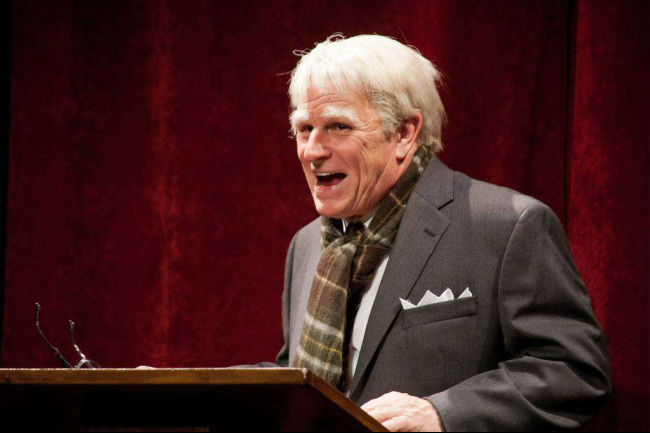
"Emmy Winner and Tony Nominee Gordon Clapp portrays the iconic American poet in A.M. Dolan's one-man play, under the direction of Gus Kaikkonen. The play opens in the style of Frost's frequent public appearances, in which he was known to speak extemporaneously for several minutes about whatever was on his mind before launching into readings of his poetry. Addressing the audience from behind a podium, Clapp immediately captures Frost's dry, sometimes self-deprecating humor. We're introduced first to the professor and public speaker, and later, we get a glimpse into Frost's private life.
Dolan's script weaves Frost's poetry and personal views into a seamless piece of theater, which Clapp delivers with authentic New England wit and charm... The piece succeeds in keeping its audience captivated for an entire 75 minutes without an intermission - no small feat for a one-person play. Clapp's charisma never falters, and 75 minutes feels like 25. This Lost Nation presentation is a must-see!" Broadway World, September 8, 2013
Dolan's script weaves Frost's poetry and personal views into a seamless piece of theater, which Clapp delivers with authentic New England wit and charm... The piece succeeds in keeping its audience captivated for an entire 75 minutes without an intermission - no small feat for a one-person play. Clapp's charisma never falters, and 75 minutes feels like 25. This Lost Nation presentation is a must-see!" Broadway World, September 8, 2013
George Bernard Shaw's THE PHILANDERER
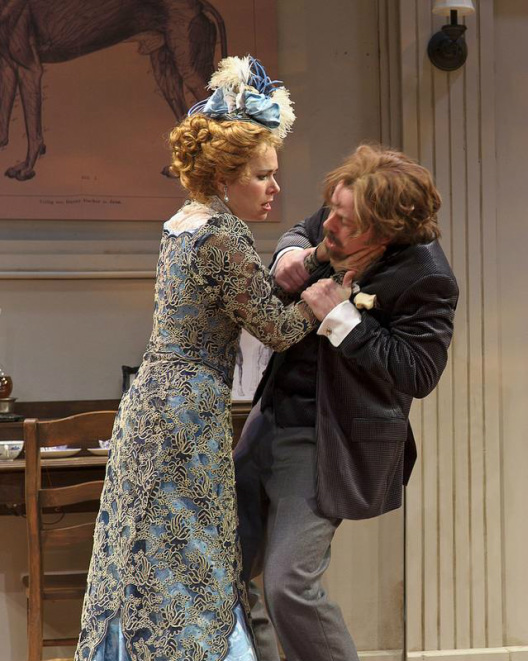 Karron Graves and Brad Cover in THE PHILANDERER at the Pearl at City Center
Karron Graves and Brad Cover in THE PHILANDERER at the Pearl at City Center
"Probably the single most startling fact about 's George Bernard Shaw's early comedy The Philanderer (City Center Stage II)—just revived by the Pearl Theatre in a juicily stylish production by Gus Kaikkonen—is that it's based on personal experience. In his mid-thirties, Shaw was simultaneously having affairs—yes, sexual affairs, coition included—with two women, a widow somewhat older than himself and an actress slightly younger...Dense and tricky, full of 1890s arcana remote from us, The Philanderer has never been anybody's favorite Shaw comedy. Yet Kaikkonen, thinning the text and giving the action a strong physical life, makes it seem both lively and pertinent to today's world...He fields a strong ensemble, revealing that the Pearl's resident company is in solid shape this year. Botchan, Cuskern, and Daily are all in elegant form here, while Cover, doing his most striking work to date, invests the unheroic hero with a greasy, mop-haired, freewheeling raffishness that perfectly matches the wicked charm of the character's attitude. Daringly, Kaikkonen gives Graves leeway to set the evening's emotional bar high; she pushes Julia's tantrums to the exact borderline of excess. Under the laugh-provoking frenzy lies not only a brainy take on the mess our passions make of our lives but also a twinge of pity from someone who'd been there himself." Michael Feingold, Village Voice February 1, 2012
 Chris Mixon in THE PHILANDERER at the Pearl at City Center
Chris Mixon in THE PHILANDERER at the Pearl at City Center
"A sparkling revival...Shaw's play is filled with cynical humor...Gus Kaikkonen directs wisely, emphasizing the little details of Shavian humor while keeping Julia's tantrums in control, even as Graves gets plenty of laughter from her well-controlled melodramatic moments." Jennifer Farrar, Associated Press
"It's a mystery to me why "The Philanderer," George Bernard Shaw's second play, is performed so infrequently... it's an entertaining and ribald report from the battle of the sexes with plenty of sparkling Shavian wit. Gus Kaikkonen directs the Pearl Theatre Company's revival with a sure and steady hand... He also skillfully balances the script's outlandishly comic aspects with its piercing observations on the man-woman question, which are as relevant today as they were when written." David Sheward, Backstage January 22,2012
Talley's Folly by Lanford Wilson

Watching Lanford Wilson’s Talley’s Folly is a little like watching a ninety-minute television nature film of mating rituals in the animal world. Two human creatures, male and female, display and retreat, feathers get ruffled, hackles raised, a little fur flies, and the end is satisfactorily predictable. That’s the nature of romantic comedy. In this case, the male in full three-piece plumage is Matt Friedman, an accountant from St. Louis who talks, in David Breitbarth’s embodiment, as if his natural habitat were Damon Runyon’s Broadway, and Sally Talley, a Missouri girl restless to escape the nest, played by Kate Hampton. The character is carefully protective of her shell, to use a metaphor straight from the script. The folly of the title is the setting, a gingerbread riverside boathouse bathed in moonlight, wondrously detailed by the scenic designer Charles Morgan, and all of it gracefully used under the direction of Gus Kaikkonen.
Jim Kates, Arts Fuse Theater, September 5, 2013
Jim Kates, Arts Fuse Theater, September 5, 2013
Anton Chekhov's The Seagull at Peterborough
 Lisa Bostnar and Jed Resnick in SEAGULL
Lisa Bostnar and Jed Resnick in SEAGULL
"The clarity and directness of this production serves The Seagull well, understanding it not as a classic of a foreign literature but as an interaction of bewildered characters stumbling through their lives. Gus Kaikkonen has proved himself before this to be a remarkably adept translator and adapter for the current stage. He didn’t create this production of The Seagull directly from the Russian text but confected it from a number of older English translations, adapting these as if making a translation— one that stays remarkably true to its distant original while feeling streamlined, contemporary, and true also to a Chekhovian ideal. Then he has directed it with a strong sense of the comic potential and a comfortable use of the particular strengths of veterans of the Peterborough Players company, with a bright sprinkling of newcomers...Russians get particularly possessive about a few of their writers, among them Chekhov. But Kaikkonen and the Players have put together a Seagull that floats elegantly on nineteenth-century Russian and twenty-first-century American wings, simultaneously bright and dark, a model of the best work of the Peterborough company in its own 80th season." Jim Kates, Fuse Theater Review, July 25, 2013
Alan Ayckbourn's ABSURD PERSON SINGULAR at Peterborough
 Kraig Swartz, Lisa Bostnar, Jack Koenig, Susan Riley Stevens, Kate Hampton and Greg Wood
Kraig Swartz, Lisa Bostnar, Jack Koenig, Susan Riley Stevens, Kate Hampton and Greg Wood
When a playwright is as prolific as Alan Ayckbourn, it doesn't make much sense to single out any of his shows as "the best." It's true, though, that Absurd Person Singular, first seen in London in 1973 and on Broadway the following year, put Mr. Ayckbourn on the international map, and of all his 77 plays, it might well be the one that sums him up most completely, in tone no less than technique. Like many of his plays, Absurd Person Singular is so funny that you can easily overlook its darkness, but the Peterborough Players' production, outstandingly well directed by Gus Kaikkonen, balances these two aspects with exhilarating exactitude...I've seen two previous revivals of Absurd Person Singular, one on Broadway in 2005 and one at Massachusetts' Barrington Stage in 2010. Both were very well acted but not quite so well staged. This one, by contrast, succeeds on both counts. Mr. Kaikkonen, who directed the Mint Theater Company's important off-Broadway revival of N.C. Hunter's A Picture of Autumn earlier this summer, manages the play's whirling physical comedy with impressive skill. At the same time, though, he italicizes the discomfort of Mr. Ayckbourn's characters, which is embodied in Sidney ( Kraig Swartz ), an ambitious lower-middle-class businessman who longs above all things to be socially respectable. You'll laugh at his hopes—but you'll never forget why you're laughing. While Mr. Swartz's cringing, clueless obsequiousness is especially noteworthy, each member of Mr. Kaikkonen's six-person ensemble cast gives a performance in which his or her character's essential qualities are fully realized. That's part of what makes this production come across so strongly: Everyone in it seems as real as a next-door neighbor...Such realism is harder to bring off than it looks, especially in a comedy, and Mr. Kaikkonen and his actors deserve the highest possible praise for never stooping to jokey excess. Absurd Person Singular is a pure situation comedy—it doesn't contain so much as one punch line—in which all of the laughter arises from ruthless truthfulness...
The Peterborough Players, who work out of a converted barn on the outskirts of the New Hampshire village that was the real-life setting for Thornton Wilder's Our Town, have a long track record of artistic excellence (the company turns 80 this season). Under Mr. Kaikkonen's wise stewardship, they've racked up a string of summertime triumphs, among them a 2008 production of the Wilder play in which James Whitmore played the Stage Manager with unassuming eloquence. This revival of Absurd Person Singular is among their very finest efforts. Terry Teachout, Wall Street Journal, August 22, 2013
The Peterborough Players, who work out of a converted barn on the outskirts of the New Hampshire village that was the real-life setting for Thornton Wilder's Our Town, have a long track record of artistic excellence (the company turns 80 this season). Under Mr. Kaikkonen's wise stewardship, they've racked up a string of summertime triumphs, among them a 2008 production of the Wilder play in which James Whitmore played the Stage Manager with unassuming eloquence. This revival of Absurd Person Singular is among their very finest efforts. Terry Teachout, Wall Street Journal, August 22, 2013
A. R. Gurney's ANCESTRAL VOICES at Peterborough
 Elise Williams, Dale Hodges, David Howard, Kraig Swartz, Sevanne Martin, Tom Frey
Elise Williams, Dale Hodges, David Howard, Kraig Swartz, Sevanne Martin, Tom Frey
A.R. Gurney is another playwright who rarely fails to find new things to say about old subjects, and "Ancestral Voices" is among his strongest efforts in that line, a portrait of a family of old-money WASPs from upstate New York whose tight ranks have been cleaved by the wedge of divorce. First presented by New York's Lincoln Center Theater in 1999, "Ancestral Voices" was written to be done as a staged reading by five actors who play multiple roles and remain seated throughout the show—but Gus Kaikkonen, artistic director of New Hampshire's Peterborough Players, has chosen instead to mount it as a fully staged play performed by a cast of 13. Though I can't say whether Mr. Gurney would approve, Mr. Kaikkonen
 David Howard and Kraig Swartz in ANCESTRAL VOICES
David Howard and Kraig Swartz in ANCESTRAL VOICES
has directed "Ancestral Voices" with such fluidity and attention to detail that it works at least as well in this new form.
I confess with embarrassment to having misjudged "Ancestral Voices" when I saw the original production. Back then it struck me as a white-bread rewrite of Woody Allen's "Radio Days." Now I find it extraordinarily moving, a searching look at a class of once-confident Americans who have (in the words of one of the characters) "lost our usefulness" and are seeking new ways to live, some more successfully than others. Here as in "The Dining Room," the 1981 play that put him on the map of American theater, Mr. Gurney passes intense nostalgia for the lost world of his childhood through the fracturing prism of adult disillusion ("Every family has a hole in it somewhere"). The result is a play whose charming comic touches barely sweeten the pill of regret.
Mr. Kaikkonen's cast is exemplary, with top honors going to David S. Howard, who made a powerful impression earlier this year in Asolo Rep's superb revival of "Twelve Angry Men." Here he plays the despondent grandfather whose wife (Dale Hodges) leaves him for his best friend (also played by Mr. Howard, an exceedingly neat trick). The soft-spoken delicacy of Mr. Howard's performance is but one highlight of a show rich in understated pleasures.
Terry Teachout, Wall Street Journal, July 22, 2011
I confess with embarrassment to having misjudged "Ancestral Voices" when I saw the original production. Back then it struck me as a white-bread rewrite of Woody Allen's "Radio Days." Now I find it extraordinarily moving, a searching look at a class of once-confident Americans who have (in the words of one of the characters) "lost our usefulness" and are seeking new ways to live, some more successfully than others. Here as in "The Dining Room," the 1981 play that put him on the map of American theater, Mr. Gurney passes intense nostalgia for the lost world of his childhood through the fracturing prism of adult disillusion ("Every family has a hole in it somewhere"). The result is a play whose charming comic touches barely sweeten the pill of regret.
Mr. Kaikkonen's cast is exemplary, with top honors going to David S. Howard, who made a powerful impression earlier this year in Asolo Rep's superb revival of "Twelve Angry Men." Here he plays the despondent grandfather whose wife (Dale Hodges) leaves him for his best friend (also played by Mr. Howard, an exceedingly neat trick). The soft-spoken delicacy of Mr. Howard's performance is but one highlight of a show rich in understated pleasures.
Terry Teachout, Wall Street Journal, July 22, 2011
 Gordon Clapp and Kathy Manfre in AULD LANG SYNE
Gordon Clapp and Kathy Manfre in AULD LANG SYNE
The World Premiere of Jack Neary's
AULD LANG SYNE
at Peterborough
Thursday, January 31, 2013) DERRY — The Peterborough Players took top awards in seven categories at the 11th Annual N.H. Theatre Awards on Saturday. Auld Lang Syne brought in five of them, with honors for best production, best director for Peterborough Players Artistic Director Gun Kaikkonen, best original playwright for Jack Neary, best actor for Gordon Clapp — known for his work on the television series “NYPD Blue” — and best actress for Kathy Manfre of Peterborough.
Monadnock Ledger Transcript
AULD LANG SYNE
at Peterborough
Thursday, January 31, 2013) DERRY — The Peterborough Players took top awards in seven categories at the 11th Annual N.H. Theatre Awards on Saturday. Auld Lang Syne brought in five of them, with honors for best production, best director for Peterborough Players Artistic Director Gun Kaikkonen, best original playwright for Jack Neary, best actor for Gordon Clapp — known for his work on the television series “NYPD Blue” — and best actress for Kathy Manfre of Peterborough.
Monadnock Ledger Transcript
 Ryan Farley and Karen Peakes in MEASURE FOR MEASURE
Ryan Farley and Karen Peakes in MEASURE FOR MEASURE
MEASURE FOR MEASURE
at Peterborough
"Director Gus Kaikkonen has created a brilliantly staged production at the Peterborough Players, freeing up the sticking points in this “problem” play by relying confidently on its comedy. A perhaps implied but unscripted recognition scene adds a grand, funny touch as well as credibility to the last act. The Players take on the underlying darkness by setting Measure for Measure in 1930—a different Vienna from that of dukes and monks but not unbridgeably different. Bridget Beirne turns the whoremonger Mistress Overdone (nine husbands, “Overdone by the last”) into a sultry cabaret singer punctuating the scenes with singularly appropriate songs by Kurt Weill and Frederich Hollander. (Ellen Mandel arranged the music.) Proto-Nazi-looking uniforms (designed by Lara de Bruijn) on the guards and officers add just a touch of menace. "
Jim Kates, Fuse Theater Review
Winner of seven 2011 New Hampshire Theater Awards:
Best Production
Best Direction: Gus Kaikkonen
Best Actress: Karen Peakes
Best Scenic Design: Charles Morgan
Best Costume Design: Lara de Bruijn
Best Lighting Design: John Eckert
Best Sound Design: Kevin Frazier
at Peterborough
"Director Gus Kaikkonen has created a brilliantly staged production at the Peterborough Players, freeing up the sticking points in this “problem” play by relying confidently on its comedy. A perhaps implied but unscripted recognition scene adds a grand, funny touch as well as credibility to the last act. The Players take on the underlying darkness by setting Measure for Measure in 1930—a different Vienna from that of dukes and monks but not unbridgeably different. Bridget Beirne turns the whoremonger Mistress Overdone (nine husbands, “Overdone by the last”) into a sultry cabaret singer punctuating the scenes with singularly appropriate songs by Kurt Weill and Frederich Hollander. (Ellen Mandel arranged the music.) Proto-Nazi-looking uniforms (designed by Lara de Bruijn) on the guards and officers add just a touch of menace. "
Jim Kates, Fuse Theater Review
Winner of seven 2011 New Hampshire Theater Awards:
Best Production
Best Direction: Gus Kaikkonen
Best Actress: Karen Peakes
Best Scenic Design: Charles Morgan
Best Costume Design: Lara de Bruijn
Best Lighting Design: John Eckert
Best Sound Design: Kevin Frazier


